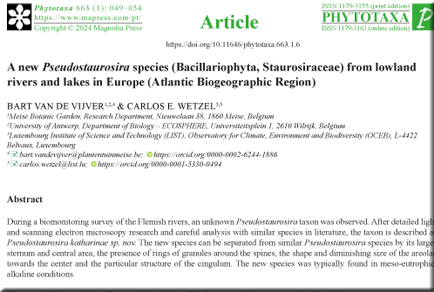Abstract
During a biomonitoring survey of the Flemish rivers, an unknown Pseudostaurosira taxon was observed. After detailed light and scanning electron microscopy research and careful analysis with similar species in literature, the taxon is described as Pseudostaurosira katharinae sp. nov. The new species can be separated from similar Pseudostaurosira species by its larger sternum and central area, the presence of rings of granules around the spines, the shape and diminishing size of the areolae towards the center and the particular structure of the cingulum. The new species was typically found in meso-eutrophic, alkaline conditions.
References
- André, C., Sabbe, K. & Van de Vijver, B. (2023) Pseudostaurosira ellipticolanceolata, a new araphid diatom (Bacillariophyta) from Flanders, Belgium. Phytotaxa 591 (1): 83–86. https://doi.org/10.11646/phytotaxa.591.1.10
- Beauger, A., Wetzel, C.E., Voldoire, O. & Ector, L. (2019) Pseudostaurosira bardii (Fragilariaceae, Bacillariophyta), a new species from a saline hydrothermal spring of the Massif Central (France). Botany Letters 166 (1): 3–13. https://doi.org/10.1080/23818107.2018.1460278
- Cejudo-Figueiras, C., Morales, E.A., Wetzel, C.E., Blanco, S., Hoffmann, L. & Ector, L. (2011) Analysis of the type of Fragilaria construens var. subsalina (Bacillariophyceae) and description of two morphologically related taxa from Europe and the United States. Phycologia 50 (1): 67–77. https://doi.org/10.2216/09-40.1
- Ehrenberg, C.G. (1843a) Mittheilungen über 2 neue asiatische Lager fossiler Infusorien-Erden aus dem russischen Trans-Kaukasien (Grusien) und Sibirien. Bericht über die zur Bekanntmachung geeigneten Verhandlungen der Königlich-Preussischen Akademie der Wissenschaften zu Berlin 1843: 43–49.
- Ehrenberg, C.G. (1843b) Verbreitung und Einfluss des mikroskopischen Lebens in Süd- und Nord-Amerika. Abhandlungen der Königlichen Akademie der Wissenschaften zu Berlin 1841: 291–445.
- García, M.L., Bustos, S., Villacís, L.A., Laprida, C., Mayr, C., Moreno, P.I., Maidana, N.I. & Morales, E.A. (2021) New araphid species of the genus Pseudostaurosira (Bacillariophyceae) from southern Patagonia. European Journal of Phycology 56 (3): 255–272. https://doi.org/10.1080/09670262.2020.1813810
- Grana, L., Morales, E.A., Maidana, N.I. & Ector, L. (2018) Two new species of Staurosira and Pseudostaurosira (Bacillariophyta) from the highlands of Argentina (south-central Andes) and two new nomenclatural combinations. Phytotaxa 365 (1): 60–72. https://doi.org/10.11646/phytotaxa.365.1.2
- Guiry, M.D. & Guiry, G.M. (2024) AlgaeBase. World-wide electronic publication, National University of Ireland, Galway. Available from: https://www.algaebase.org (accessed 19 June 2024)
- Hustedt, F. (1925) Bacillariales aus den Salzgewässern bei Oldesloe in Holstein. Mitteilungen der geographischen Gesellschaft und der Naturhistorischen Museums in Lubeck, zweite Reihe 30: 84–121.
- Kulikovskiy, M.S., Lange-Bertalot, H. & Kuznetsova, I.V. (2015) Lake Baikal: hotspot of endemic diatoms II. Iconographia Diatomologica 26: 1– 656.
- Kützing, F.T. (1844) Die kieselschaligen Bacillarien oder Diatomeen. W. Köhne, Nordhausen, 144 pp. https://doi.org/10.5962/bhl.title.64360
- Lyngbye, H.C. (1819) Tentamen hydrophytologiae danicae continens omnia hydrophyta cryptogama Daniae, Holsatiae, Faeroae, Islandiae, Groenlandiae hucusque cognita, systematice disposita, descripta et iconibus illustrata, adjectis simul speciebus norvegicis. Hafniae, Copenhagen, Denmark, 248 pp, 70 pls. https://doi.org/10.5962/bhl.title.6079
- Marchyllie, M. (1992) Reserve biologique domaniale de la Mare à Goriaux: étude des roselières en vue de leur restrauration et de leur gestion. 101 pp.
- Marquardt, G.C., Bicudo, D.C., Bicudo, C.E.M., Ledru, M.-P., Ector, L. & Wetzel, C.E. (2021) Pseudostaurosira crateri sp. nov. (Fragilariaceae, Bacillariophyta), a new small araphid, fossil diatom species from the Pleistocene (Atlantic Forest, Brazil). Phytotaxa 496 (2): 105–120. https://doi.org/10.11646/phytotaxa.496.2.1
- Morales, E.A. (2002) Studies in selected fragilarioid diatoms of potential indicator value from Florida (USA) with notes on the genus Opephora Petit (Bacillariophyceae). Limnologica 32: 102–113. https://doi.org/10.1016/S0075-9511(02)80002-0
- Morales, E.A. (2005) Observations of the morphology of some known and new fragilarioid diatoms (Bacillariophyceae) from rivers in the USA. Phycological Research 53 (2): 113–133.
- Morales, E.A. (2021) Transfer of Fragilaria neoelliptica Witkowski to the genus Nanofrustulum Round, Hallsteinsen & Paasche (Fragilariaceae, Bacillariophyta). Notulae Algarum 205: 1–4.
- Morales, E.A., Wetzel, C.E., Novais, M.H., Buczkó, K., Morais, M.M. & Ector, L. (2019) Morphological reconsideration of the araphid genus Pseudostaurosira (Bacillariophyceae), a revision of Gedaniella, Popovskayella and Serratifera, and a description of a new Nanofrustulum species. Plant Ecology and Evolution 152 (2): 262–284. https://doi.org/10.5091/plecevo.2019.1604
- Morales, E.A., Wetzel, Z.E. & Ector, L. (2021) New and poorly known “araphid” diatom species (Bacillariophyta) from regions near Lake Titicaca, South America and a discussion on the continued use of morphological characters in “araphid” diatom taxonomy. PhytoKeys 187: 23–70. https://doi.org/10.3897/phytokeys.187.73338
- Salinas, V.H., Mora, D., Jahn, R. & Abarca, N. (2020) New species of Pseudostaurosira (Bacillariophyceae) including a tripolar taxon from mountain streams of Central Mexico. Phytotaxa 464 (3): 193–206. https://doi.org/10.11646/phytotaxa.464.3.1
- Simonsen, R. (1979) The diatom system: ideas on phylogeny. Bacillaria 2: 9–71.
- Turland, N.J., Wiersema, J.H., Barrie, F.R., Greuter, W., Hawksworth, D.L., Herendeen, P.S., Knapp, S., Kusber, W.-H., Li, D.-Z., Marhold, K., May, T.W., McNeill, J., Monro, A.M., Prado, J., Price, M.J. & Smith, G.F. (Eds.) (2018) International Code of Nomenclature for algae, fungi, and plants (Shenzhen Code) adopted by the Nineteenth International Botanical Congress Shenzhen, China, July 2017, Vol. 159. Regnum Vegetabile, Koeltz Botanical Books, Glashütten, pp. [i]–xxxviii, 1–253.
- Van de Vijver, B., Peeters, V., Ballings, P. & de Haan, M. (2024) Five new species in the genus Staurosirella (Bacillariophyta) from European freshwater habitats. PhytoKeys 242: 139–160. https://doi.org/10.3897/phytokeys.242.122458
- Van Heurck, H. (1882) Synopsis des Diatomées de Belgique. Atlas. Ducaju et Cie, Anvers, pp. pls LXXVIII–CXXXII.
- Van Heurck, H. (1885) Synopsis des Diatomées de Belgique. Texte. Martin Brouwers & Co, Anvers, pp. [1]–235.
- van der Werff, A. (1955) A new method of concentrating and cleaning diatoms and other organisms. Verhandlungen der Internationalen Verein für Theoretische und Angewandte Limnologie 12: 276–277. https://10.1080/03680770.1950.11895297


